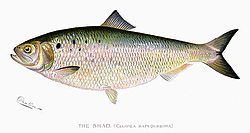| American shad | |
|---|---|

| |
| Watercolor of an American shad by Sherman F. Denton, 1904: The swelling between the anal fin and ventral fin identifies this as a gravid female. | |
| Scientific classification | |
| Domain: | Eukaryota |
| Kingdom: | Animalia |
| Phylum: | Chordata |
| Class: | Actinopterygii |
| Order: | Clupeiformes |
| Family: | Alosidae |
| Genus: | Alosa |
| Species: | A. sapidissima
|
| Binomial name | |
| Alosa sapidissima (A. Wilson, 1811)
| |
| Synonyms | |
|
Clupea sapidissima | |
The American shad (Alosa sapidissima) is a species of anadromous clupeid fish naturally distributed on the North American coast of the North Atlantic, from Newfoundland to Florida,[2] and as an introduced species on the North Pacific coast. The American shad is not closely related to the other North American shads. Rather, it seems to form a lineage that diverged from a common ancestor of the European taxa before these diversified.[3]
The American shad has been described as "the fish that fed the (American) nation's founders".[4][5] Adult shad weigh between 1.5 and 3.5 kg (3 and 8 lb), and they have a delicate flavor when cooked.[6] It is considered flavorful enough not to require sauces, herbs, or spices. It can be boiled, filleted and fried in butter, or baked. Traditionally, a little vinegar is sprinkled over it on the plate. In the Eastern United States, roe shads (females) are prized because the eggs are considered a delicacy.[7]
The name "shad" derives from the Old English sceadd, meaning "herring"; it is a cognate to Irish, Welsh, and Scottish Gaelic words for herring.[8]
- ^ NatureServe.; Daniels, A. (2019). "Alosa sapidissima". IUCN Red List of Threatened Species. 2019: e.T191206A82664336. doi:10.2305/IUCN.UK.2019-2.RLTS.T191206A82664336.en. Retrieved 12 November 2021.
- ^ Cite error: The named reference
FBwas invoked but never defined (see the help page). - ^ Faria, R.; Weiss, S. & Alexandrino, P. (2006): A molecular phylogenetic perspective on the evolutionary history of Alosa spp. (Clupeidae). Molecular Phylogenetics and Evolution 40(1): 298–304. doi:10.1016/j.ympev.2006.02.008
- ^ Cite error: The named reference
wheeler2015was invoked but never defined (see the help page). - ^ Boyle, Robert H. (8 December 2002). "A Sense of Where They Are". The New York Times.
- ^ "Grass Shad-another Fine Bait- Southeastern King Mackerel Club – King Mackerel Fishing in Southeastern North Carolina." Southeastern King Mackerel Club – King Mackerel Fishing in Southeastern North Carolina-. Web. 15 Dec. 2011. <http://southeasternkingmackerelclub.com/grass-shad-another-fine-bait/ Archived 2012-04-26 at the Wayback Machine>.
- ^ Cite error: The named reference
RedOrbitwas invoked but never defined (see the help page). - ^ Shad. Oxford English Dictionary. Retrieved 7 November 2017.
